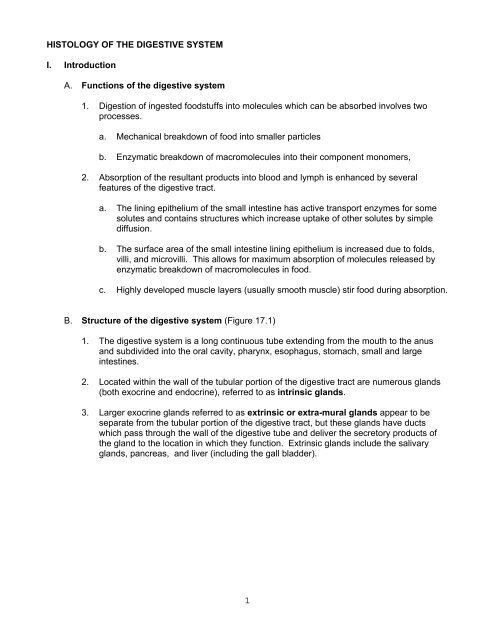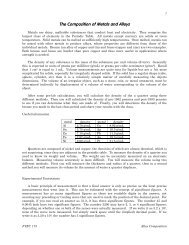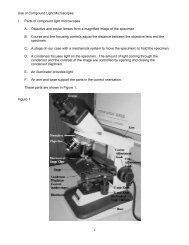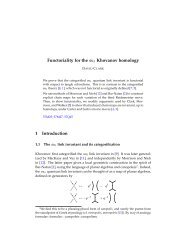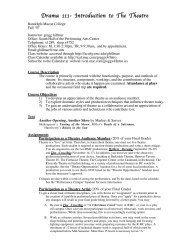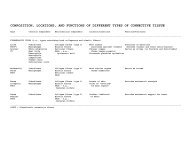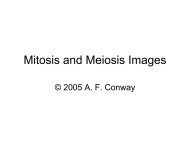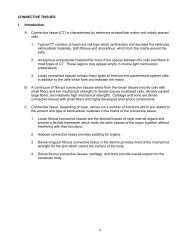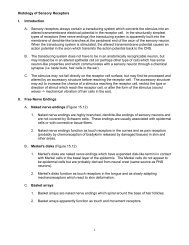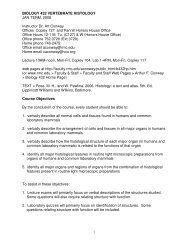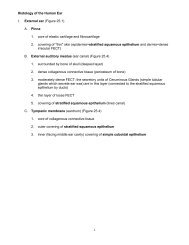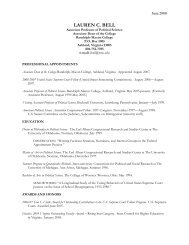HISTOLOGY OF THE DIGESTIVE SYSTEM I ... - Faculty.rmc.edu
HISTOLOGY OF THE DIGESTIVE SYSTEM I ... - Faculty.rmc.edu
HISTOLOGY OF THE DIGESTIVE SYSTEM I ... - Faculty.rmc.edu
Create successful ePaper yourself
Turn your PDF publications into a flip-book with our unique Google optimized e-Paper software.
<strong>HISTOLOGY</strong> <strong>OF</strong> <strong>THE</strong> <strong>DIGESTIVE</strong> <strong>SYSTEM</strong><br />
I. Introduction<br />
A. Functions of the digestive system<br />
1. Digestion of ingested foodstuffs into molecules which can be absorbed involves two<br />
processes.<br />
a. Mechanical breakdown of food into smaller particles<br />
b. Enzymatic breakdown of macromolecules into their component monomers,<br />
2. Absorption of the resultant products into blood and lymph is enhanced by several<br />
features of the digestive tract.<br />
a. The lining epithelium of the small intestine has active transport enzymes for some<br />
solutes and contains structures which increase uptake of other solutes by simple<br />
diffusion.<br />
b. The surface area of the small intestine lining epithelium is increased due to folds,<br />
villi, and microvilli. This allows for maximum absorption of molecules released by<br />
enzymatic breakdown of macromolecules in food.<br />
c. Highly developed muscle layers (usually smooth muscle) stir food during absorption.<br />
B. Structure of the digestive system (Figure 17.1)<br />
1. The digestive system is a long continuous tube extending from the mouth to the anus<br />
and subdivided into the oral cavity, pharynx, esophagus, stomach, small and large<br />
intestines.<br />
2. Located within the wall of the tubular portion of the digestive tract are numerous glands<br />
(both exocrine and endocrine), referred to as intrinsic glands.<br />
3. Larger exocrine glands referred to as extrinsic or extra-mural glands appear to be<br />
separate from the tubular portion of the digestive tract, but these glands have ducts<br />
which pass through the wall of the digestive tube and deliver the secretory products of<br />
the gland to the location in which they function. Extrinsic glands include the salivary<br />
glands, pancreas, and liver (including the gall bladder).<br />
1
II.<br />
Microanatomy of the Tubular Portion of the Digestive Tract<br />
A. Typical Pattern of Layers in Digestive Tract Walls (Figure 17.1)<br />
1. Mucosa (lining of lumen)<br />
a. Epithelium = varies with location: stratified squamous in the mouth, esophagus,<br />
and anus; simple columnar in the stomach and intestines<br />
b. Lamina propria = loose FECT<br />
c. +/- Muscularis mucosae (thin) - smooth muscle<br />
2. Submucosa<br />
Loose to moderately dense FECT<br />
3. Muscularis externa<br />
Smooth muscle along most of the gut<br />
Skeletal muscle near both ends of the gut<br />
Usually consists of inner circular and outer longitudinal layers<br />
4. Adventitia or Serosa<br />
Adventitia = loose FECT (on organ surfaces embedded in connective tissue)<br />
Serosa = loose FECT + mesothelium (on organ surfaces exposed to body cavities)<br />
B. Oral Cavity and Pharynx (excluding nasopharynx)<br />
1. Mucosa (Plate 44)<br />
a. Epithelium = stratified squamous epithelium (Figure 16.2, 16.4)<br />
The epithelium is heavily keratinized on the upper (dorsal) surface of the tongue, is<br />
moderately keratinized on the hard palate and on parts of the gums, and is nonkeratinized<br />
elsewhere.<br />
b. Lamina propria + Submucosa (Figure 16.4)<br />
The lamina propria and submucosa are not clearly separated in most of the oral<br />
cavity and pharynx. A very thin layer of loose FECT occurs at the base of the<br />
epithelium in most areas. Most of the deeper connective tissue is moderately dense<br />
FECT or dense irregular FECT in most locations. Minor salivary glands<br />
(compound sero-mucous, tubulo-acinar glands) lie in the connective tissue on parts<br />
of the tongue and lateral walls of the oral cavity, and the connective tissue around<br />
those glands is loose FECT. Nodular dense lymphoid tissue lies below the<br />
epithelium lining the crypts of the tonsils.<br />
2
2. Teeth (Figure 16.6, 16.7, 16.10 - 16.20)<br />
a. Enamel (outer layer of crown of tooth)<br />
Enamel is formed by ameloblasts prior to eruption of the tooth. Since the<br />
ameloblasts are destroyed in the process of tooth eruption, enamel cannot be<br />
repaired or replaced on an existing tooth in humans. Enamel contains 96% calcium<br />
salts (hydroxyapatite), 1% organic matrix, and 3% water, making it the hardest<br />
material in the human body.<br />
b. Dentin<br />
Dentin is formed by odontoblasts throughout life. Dentin contains 70% calcium salts<br />
(hydroxyapatite) and 20% organic matrix (90% of which is collagen), and 10%<br />
water.<br />
c. Dental Pulp<br />
(1) Odontoblast layer<br />
Odontoblasts form a simple columnar epithelium between the dentin and the<br />
core of the dental pulp. The odontoblasts extend long apical processes through<br />
the dentin to the dentin- enamel junction. Associations of odontoblast<br />
processes and cell bodies with sensory nerve fibers suggest that odontoblasts<br />
may be involved in pain reception, at least at the dentin-enamel interface.<br />
(2) Core of loose FECT<br />
d. Cementum<br />
The core connective tissue contains fibroblasts and fine collagen fibers similar<br />
to those in mucous CT, but also contains macrophages, mast cells, leucocytes,<br />
and numerous capillaries and nerves. Both sensory and autonomic "motor"<br />
fibers have been reported to be present in dental pulp.<br />
Cementum is a bone matrix-like matrix material which is acellular near the crown of<br />
the tooth, but contains osteocyte-like cementocytes near the root of the tooth.<br />
Unlike bone, cementum is avascular.<br />
e. Periodontal Ligament<br />
The periodontal ligament (or membrane) is a layer of dense collagenous connective<br />
tissue interspersed with loose FECT containing nerve endings and blood vessels.<br />
This tissue attaches the cementum on the root of the tooth to the surrounding<br />
alveolar bone in a strong but flexible manner.<br />
3
f. Alveolar Bone<br />
Alveolar bone consists of a surface layer of compact bone (with some areas of<br />
woven bone) supported by a core of spongy bone. The alveolar bone surrounds the<br />
root of the tooth.<br />
g. Gingiva<br />
Gingiva is covered by a moderately keratinized stratified squamous epithelium in<br />
which dermal papillae are more numerous than in most areas of oral mucosa. The<br />
epithelium at the gingival "cuff" is attached to the tooth surface by basal lamina- like<br />
material, sealing the periodontal ligament from the oral cavity.<br />
3. Tongue (Figure 16.4, 16.5, Plate 45, 46)<br />
a. The tongue is covered by oral mucosa. The epithelium on the upper surface is<br />
heavily keratinized in places, particularly on the tips of filiform papillae.<br />
b. The tongue contains a core of skeletal muscle arranged in bundles. The bundles<br />
run in 3 planes at right angles to each other (i.e. in X, Y, and Z geometric axes)<br />
allowing movement of the tongue in almost any direction and allowing delicate<br />
controlled changes in the shape of the tongue.<br />
c. The upper surface of the tongue (the epithelium plus the adjacent lamina propria)<br />
forms numerous finger- like papillae which are classified into 3 categories.<br />
(1) Filiform Papillae<br />
(a) Pointed tip<br />
(b) Heavily keratinized epithelium<br />
(c) No taste buds<br />
(d) Most numerous type of papilla<br />
(2) Fungiform Papillae<br />
(a) Flattened apex<br />
(b) Moderately keratinized epithelium<br />
(c) Apical taste buds<br />
(d) Second most numerous type<br />
4
(3) Circumvallate Papillae<br />
(a) Flattened apex<br />
(b) Moderately keratinized epithelium<br />
(c) Lateral taste buds in the papilla and in the surrounding structures<br />
(d) Surrounded by a groove with compound serous glands (von Ebner's<br />
glands) secreting into its base<br />
(e) Least numerous type of papilla<br />
C. Esophagus (Figure 17.2 - 17.6, Plate 50, 51)<br />
1. Mucosa<br />
a. Epithelium - Stratified squamous epithelium<br />
b. Lamina propria - loose FECT, may contain branched tubular cardiac glands near the<br />
upper and lower ends of the esophagus<br />
c. Muscularis mucosae - usually longitudinally arranged smooth muscle<br />
2. Submucosa<br />
a. Loose to moderately dense FECT<br />
b. May contain mucous-secreting branched (occasionally compound) tubulo-acinar<br />
glands<br />
3. Muscularis externa<br />
a. Two layers<br />
Inner layer = (more or less) circular<br />
Outer layer = (more or less) longitudinal<br />
b. Skeletal muscle is gradually replaced by smooth muscle<br />
upper 1/3 of esophagus - mostly skeletal muscle<br />
middle 1/3 of esophagus - mixed<br />
lower 1/3 of esophagus - mostly smooth muscle<br />
4. Adventitia/Serosa<br />
Loose FECT -/+ outer mesothelium<br />
5
D. Stomach (Figure 17.5 - 17.16, Plate 51, 52, 54)<br />
1. Mucosa<br />
a. Epithelium<br />
(1) Mainly simple columnar; may be pseudostratified columnar in regions<br />
containing some types of enterochromaffin (APUD) cells (unicellular endocrine<br />
glandular epithelium)<br />
(2) Most cells of the lumen lining are mucous- secreting so the lining epithelium<br />
may be called a sheet gland<br />
(3) Enterochromaffin cells (or APUD cells) are small with basally located light<br />
cytoplasm and dark nuclei. At least some of these cells extend a sensory<br />
process to the luminal surface. Some may have acidophilic granules at the<br />
basal end.<br />
b. Lamina propria - loose FECT<br />
c. Muscularis mucosae - inner circular and outer longitudinal smooth muscle layers,<br />
frequently in bundles<br />
d. Other features<br />
(1) The mucosa forms longitudinal folds or rugae.<br />
(2) The mucosa contains gastric glands (simple tubular glands) which are referred<br />
to as cardiac glands, fundic glands, or pyloric glands based on the gland<br />
structure and the region of the stomach in which the gland is normally found.<br />
Pure cardiac and pyloric glands would contain only mucus-secreting cells plus<br />
occasional enterochromaffin cells while fundic glands contain multiple exocrine<br />
cell types.<br />
(a) Cardiac glands are branched tubular glands which occur in a narrow zone<br />
near the esophageal-stomach junction. They are usually shorter and less<br />
coiled than pyloric glands.<br />
(b) Pyloric glands are located near the pyloric region of the stomach. These<br />
branched tubular glands are usually longer and more highly coiled than<br />
cardiac glands.<br />
(c) Fundic glands occur throughout most of the stomach. These branched<br />
tubular glands contain three exocrine cell types plus numerous solitary<br />
endocrine cells.<br />
[1] Exocrine cell types<br />
[a] Chief cells (or zymogenic or peptic cells) (Figure 17.8, 17.9)<br />
- relatively columnar cells with basal nuclei, basophilic basal<br />
cytoplasm and acidophilic apical cytoplasm containing<br />
acidophilic secretory granules<br />
- serous secretory cells which secrete pepsinogen<br />
- located in the deeper 1/3 of the glands<br />
6
[b] Parietal cells (or oxyntic cells) (Figure 17.8, 17.10, 17.11)<br />
- spherical or triangular cells with central nuclei and canaliculi<br />
and with acidophilic cytoplasm<br />
- secrete HCl and intrinsic factor<br />
- occur singly or in small groups throughout the deeper 2/3 of<br />
the glands<br />
[c] Mucous cells (Figure 17.8)<br />
- columnar cells with pale staining cytoplasm<br />
- mucous secretory cells<br />
- located throughout the glands but predominate in the upper<br />
1/3 of the glands<br />
[2] Enteroendocrine cells (enterochromaffin cells)(Figure 17.12, 17.13)<br />
- different cells secrete a variety of locally acting hormones (mostly<br />
peptides or proteins such as secretin, cholecystokinin, secretin,<br />
and gastric inhibitory peptide) which coordinate gut functions.<br />
Some of the secretory granules may be acidophilic while others<br />
may not stain well.<br />
- some of these cells have the properties of enterochromaffin cells<br />
also called APUD (amine precursor uptake and decarboxylation)<br />
cells<br />
- most of these cells are small, basally located cells with light<br />
cytoplasm and moderately heterochromatic nuclei. A thin<br />
cytoplasmic process may extend to the apical surface of the<br />
epithelium.<br />
2. Submucosa<br />
loose to moderately dense FECT<br />
3. Muscularis externa<br />
two or three (most common) layers of smooth muscle<br />
a. Where two layers are present they are organized into inner circular and outer<br />
longitudinal layers.<br />
b. Where three layers are present they are organized into inner oblique, middle<br />
circular, and outer longitudinal layers.<br />
c. As is the case with other "pear-shaped" or oval organs, the muscle tends to run in<br />
bundles rather than in distinct layers.<br />
4. Serosa<br />
loose FECT and outer mesothelium<br />
7
E. Small intestine (Figure 17.17 - 17.31, Plate 54, 55, 56, 57)<br />
1. Mucosal features occurring throughout the small intestine<br />
a. The mucosa and submucosa of the small intestine are involved in permanent<br />
transverse folds called plicae circulares.<br />
b. Numerous villi (small finger-like projections) extend from the surface into the lumen.<br />
These occur in all regions of small intestine, but do not occur in large intestine<br />
mucosa.<br />
c. Numerous simple tubular glands (Crypts of Lieberkuhn) extend from the surface<br />
into the lamina propria. These occur in both small and large intestine mucosa.<br />
d. The epithelium lining both villi and crypts varies from simple columnar to<br />
pseudostratified columnar (where endocrine cells occur). The following cell types<br />
occur in the epithelia of both crypts and villi (except as noted)<br />
(1) Enterocytes - intestinal absorptive cells (Figure 17.21, 17.26, 17.29 – 17.31)<br />
(a) Enterocytes are tall columnar cells with elongated ovoid somewhat basally<br />
located nuclei and apical microvilli.<br />
(b) Various enzymes (disaccharidases, peptidases, enteropeptidase [also<br />
called enterokinase]) are integral glycoproteins of the plasma membrane<br />
and glycocalyx covering the microvilli.<br />
(c) Functions<br />
[1] The enteropeptidase on enterocytes can activate trypsinogen<br />
(becomes trypsin) which can then activate the other enzymes secreted<br />
by the pabcreas.<br />
[2] The cell surface enzymes on enterocytes digest disaccharides and<br />
peptides (final steps in polysaccharide and protein digestion).<br />
[3] Enterocytes absorb monosaccharides, amino acids, and lipids and<br />
release them into the sub-epithelial connective tissue (lamina propria)<br />
in the villi.<br />
(2) Goblet cells (Figure 17.22) are wine glass-shaped columnar cells with apically<br />
located mucus secretory granules and basally located heterochromatic nucleii.<br />
They are mucus-secreting unicellular exocrine glands.<br />
(3) Enteroendocrine cells (enterochromaffin cells, solitary endocrine cells)(Figure<br />
17.25)<br />
(a) These include many different cells which secrete a variety of locally acting<br />
hormones (mostly peptides or proteins such as secretin, cholecystokinin,<br />
secretin, and gastric inhibitory peptide) which coordinate gut functions.<br />
Some of the secretory granules may be acidophilic while others may not<br />
stain well.<br />
(b) Some of these cells have the properties of enterochromaffin cells also<br />
called APUD (amine precursor uptake and decarboxylation) cells.<br />
8
(c) Most of these cells are small, basally located cells with light cytoplasm and<br />
moderately heterochromatic nuclei. A thin cytoplasmic process may<br />
extend to the apical surface of the epithelium. Some of these cells contain<br />
basally located acidophilic secretory granules.<br />
(4) Paneth cells (Figure 17.24)<br />
(a) Paneth cells are pyramidal shaped cells with basally located spherical<br />
nuclei and apical eosinophilic secretory granules, and are found only at the<br />
base of Crypts of Lieberkuhn (primarily those in the small intestine).<br />
(c) Paneth cells secrete peptidase and lysozyme and can take up some types<br />
of bacteria and protozoa by phagocytosis, so they appear to function to<br />
r<strong>edu</strong>ce bacterial invasion into the crypts of Lieberkuhn.<br />
(5) M (microfold) cells (Figure 17.38)<br />
(a) M cells are nearly squamous-shaped epithelial cells which overlie Peyer's<br />
patches and other well-developed mucosal lymphoid nodules in the<br />
intestine. M cells have folded apical surfaces instead of microvilli.<br />
(c) M cells take up molecules from the intestinal lumen by endocytosis and<br />
transfer the molecules to the lymphocytes and antigen-presenting cells in<br />
the lamina propria.<br />
e. The lamina propria (connective tissue under the lining epithelium) is very loose<br />
FECT containing large populations of lymphocytes, plasma cells, granulocytes, and<br />
macrophages. The lamina propria can be viewed as diffuse lymphoid tissue.<br />
f. A muscularis mucosae containing one or two layers of smooth muscle usually<br />
separates the lamina propria from the submucosa. The muscularis mucosae may<br />
be interrupted or absent where glands or lymphoid nodules entend from the<br />
submucosa into the lamina propria.<br />
2. Duodenum (Figure 17.27, Plate 55)<br />
a. The mucosa of the duodenum is typical of the rest of the small intestine (see<br />
above).<br />
b. Submucosa - Loose to moderately dense FECT (which contains Brunner's glands<br />
in the upper duodenum). Brunner's glands are "compound" tubular glands which<br />
secrete sodium bicarbonate and mucus.<br />
c. Muscularis externa - Two layers of smooth muscle (inner circular and outer<br />
longitudinal)<br />
d. Adventitia/Serosa - loose FECT -/+ outer mesothelium<br />
3. Jejunum (Plate 56)<br />
a. The mucosa of the jejunum is typical of the rest of the small intestine (see above).<br />
9
. Submucosa - Loose to moderately dense FECT (which lacks Brunner's glands and<br />
Peyer's patches)<br />
c. Muscularis externa - Two layers of smooth muscle (inner circular and outer<br />
longitudinal)<br />
d. Adventitia/Serosa - loose FECT -/+ outer mesothelium<br />
4. Ileum (Plate 57)<br />
a. The mucosa of the ileum is typical of the rest of the small intestine (see above).<br />
b. Submucosa - Loose to moderately dense FECT. In some areas large lymphoid<br />
nodules (Peyer's patches) extend from the luminal epithelium into the submucosa.<br />
c. Muscularis externa - Two layers of smooth muscle (inner circular and outer<br />
longitudinal)<br />
d. Adventitia/Serosa - loose FECT -/+ outer mesothelium<br />
E. Large Intestine<br />
1. Colon (Figure 17.32, 17.33, Plate 58)<br />
a. The mucosa of the colon resembles the mucose of the small intestine except for the<br />
following features.<br />
(1) No villi are present.<br />
(2) Goblet cells are typically more numerous than in the small intestine.<br />
b. Submucosa - loose to moderately dense FECT<br />
c. Muscularis externa - two layers of smooth muscle (inner circular and outer<br />
longitudinal layers). The outer longitudinal layer is organized into three longitudinal<br />
bands (tenia coli) with only a thin layer around the rest of the surface.<br />
d. Serosa - loose FECT and outer mesothelium<br />
2. Appendix (Figure 17.35, Plate 59)<br />
a. The mucosa of the appendix resembles the colon except that small lymphocytes<br />
are frequently observed crossing the epithelium near lymphoid nodules.<br />
b. The submucosa is loose to moderately dense FECT containing large lymphoid<br />
nodules which frequently extend into the lamina propria, interrupting the muscularis<br />
mucosa.<br />
10
c. The muscularis externa typically contains two layers of smooth muscle (inner<br />
circular and outer longitudinal layers) and is much thinner than in the colon.<br />
d. The serosa consists of loose FECT and an outer mesothelium.<br />
3. Rectum and anal canal (Figure 17.36, 17.37, Plate 60)<br />
a. Mucosa<br />
(1) The epithelium is simple columnar in the rectum and changes over a distance<br />
of a few cells into stratified squamous in anal canal. The stratified squamous<br />
epithelium is initially nonkeratinized, but rapidly changes to keratinized near the<br />
exposed part of the anus.<br />
(2) The lamina propria is loose FECT. It merges with the papillary layer of the<br />
dermis of the skin around the anus.<br />
(3) A muscularis mucosae consisting of smooth muscle is present under the simple<br />
columnar epithelium, but usually disappears under the stratified squamous<br />
epithelium.<br />
b. The submucosa is loose to moderately dense FECT and is highly vascularized.<br />
The submucosa merges with the reticular layer of the dermis of the skin around the<br />
anus.<br />
c. Muscularis externa<br />
(1) Two layers of smooth muscle occur along most of the rectum and anus. The<br />
inner circular layer forms the internal anal sphincter in the anus while the<br />
outer longitudinal layer is fairly consistant throughout the rectum and anus.<br />
(2) Skeletal muscle (outside the smooth muscle layers) forms the external anal<br />
sphincter around the anus.<br />
(3) The muscularis externa disappears at the junction between the anus and the<br />
skin covering the outer body surface.<br />
d. The adventitia along most of the rectum and anus consists of loose FECT which<br />
merges with the hypodermis layer under the skin around the anus. Part of the<br />
rectum is exposed to the abdominal cavity and has an outer mesothelium, making<br />
the outer layer a serosa.<br />
11
III. Microanatomy of Extrinsic Exocrine Glands Associated with the Digestive Tract<br />
A. Terms used to describe ducts of compound exocrine glands<br />
1. Terms based on morphology of the lining epithelium<br />
a. Intercalated ducts<br />
- lined by simple squamous to simple cuboidal epithelia, may have myoepithelial<br />
cells<br />
- smallest ducts, connected to secretory units<br />
b. Striated ducts<br />
- lined by simple columnar epithelium with basal infoldings in the cells<br />
- function in water reabsorption from the secretions of the gland<br />
c. Excretory ducts<br />
- lined with simple columnar to stratified columnar epithelium<br />
2. Terms based on position of the duct<br />
a. Intralobular ducts<br />
- located within a lobule in a gland<br />
- therefore not located in a connective tissue septum<br />
b. Interlobular ducts<br />
- located between lobules (smaller connective tissue-wrapped components) of a<br />
gland<br />
- therefore located within a connective tissue septum which separates lobules of<br />
a gland<br />
c. Interlobar ducts<br />
- located between lobes (larger connective tissue-wrapped components) of a<br />
gland<br />
- therefore located within a connective tissue septum which separates lobes of a<br />
gland<br />
Intercalated ducts and striated ducts are always intralobular, but excretory ducts<br />
may be interlobular or interlobar. Interlobar ducts would be larger in diameter, have<br />
a thicker lining epithelium, and be running in larger connective tissue septa than<br />
interlobular ducts.<br />
12
B. Salivary glands (Figure 16.22 - 16.28, Plate 47, 48, 49)<br />
1. Three pairs of major salivary glands occur in humans<br />
a. Parotid glands<br />
b. Submandibular (submaxillary) glands<br />
c. Sublingual glands<br />
2. Minor salivary glands are widespread within the wall of the oral cavity and usually are<br />
seromucous (tubuloacinar).<br />
3. Organization of the major salivary glands<br />
a. Major salivary glands are compound acinar (serous) or compound tubulo-acinar<br />
(seromucous, also called mixed) glands.<br />
b. Secretory units are usually surrounded by myoepithelial cells.<br />
c. Ducts<br />
(1) Intercalated - simple cuboidal epithelium<br />
(2) Striated - simple columnar epithelium with basal infoldings which concentrates<br />
secretory product by removing sodium ions and water<br />
(3) Excretory - simple columnar, pseudostratified columnar, stratified cuboidal, or<br />
stratified columnar epithelium<br />
d. Capsule - moderately dense FECT<br />
e. Loose to moderately dense FECT septae divide the glands into lobes and lobules<br />
and are continuous with the loose FECT stroma within the lobules.<br />
4. The major salivary glands in humans differ in type of secretion and in the types of ducts<br />
present. Other mammals have different patterns.<br />
a. Parotid = totally pure serous acinar units with intercalated, striated, and excretory<br />
ducts present<br />
b. Submandibular = pure serous acinar units predominate but mucous units capped<br />
with serous demilunes (mixed units) occur in many areas of the gland; intercalated,<br />
striated, and excretory ducts are present.<br />
c. Sublingual = mucous acini and short tubules with serous demilunes (mixed units)<br />
are the most frequent unit. A few serous acini may occur but no large areas of<br />
serous units occur. Only intercalated and excretory ducts occur.<br />
NOTE – the demilune arrangement of the serous cells in seen in routine preparations of the<br />
submandibular and sublingual salivary glands appears to be a fixation artifact, since<br />
rapid freezing shows intermingled serous and mucous cells (see Figure 16.23).<br />
13
5. Salivary gland secretions prepare food for transport in the esophagus<br />
a. Serous secretions - contain fluid and alpha amylase (which fragments and<br />
solubilizes starchy materials) plus some immunoglobulin A (function is unclear)<br />
b. Mucous secretions - provide lubrication for food as it passes down the esophagus<br />
C. Pancreas (Figure 18.19 - 18.22, Plate 64)<br />
1. Composed of exocrine acini and Islets of Langerhans (endocrine) on a stroma of loose<br />
FECT<br />
2. Organization<br />
a. Exocrine portion contains only serous acinar units<br />
b. Ducts<br />
(1) Intercalated ducts = squamous to low cuboidal epithelium; extend into acinus as<br />
centroacinar cells<br />
(2) Intralobular ducts = simple cuboidal to simple columnar, no striated ducts are<br />
present<br />
(3) Excretory ducts are lined by simple columnar epithelium which they are located<br />
within the gland.<br />
c. Capsule is loose FECT which may be covered in some places by mesothelium<br />
3. Composition and function of exocrine secretions of the pancreas<br />
a. Amylase - breaks down starch<br />
b. Trypsinogen, chymotrypsinogen, carboxypeptidase - break down proteins/peptides<br />
c. Ribonuclease - breaks down RNA<br />
d. Lipase - breaks down lipids<br />
14
D. Liver (Figure 18.1 – 18.14, Plate 61, 62)<br />
1. The liver is composed of an epithelial parenchyma (hepatocytes) on a stroma of FECT<br />
(primarily just reticular fibers around hepatocytes). The capsule of the liver is<br />
moderately dense FECT and is surrounded in some regions by mesothelium.<br />
2. Organization<br />
a. A classical lobule has a central "vein" (actually a giant postcapillary venule)<br />
located in the center each lobule.<br />
b. Liver cells (hepatocytes) within a classical lobule are arranged in flat plates (appear<br />
as cords in two dimensions) which radiate out from central vein.<br />
c. Portal triads (portal canals, portal areas) are located at the perimeter of each<br />
lobule. Each portal triad contains<br />
(1) a branch of the hepatic artery (usually an arteriole)<br />
(2) a branch of the hepatic portal vein (usually a venule)<br />
(3) a branch of the bile duct (simple cuboidal epithelium)<br />
A lymphatic vessel is also present in many portal triads.<br />
e. Sinusoidal capillaries located between plates of hepatocytes are lined by<br />
endothelial cells and Kupffer cells (phagocytic). The sinusoids receive blood from<br />
the hepatic portal vein and from the hepatic artery and empty into the central "veins"<br />
which drain into the hepatic vein.<br />
f. Bile canaliculi (narrow channels) located between adjacent hepatocytes collect bile<br />
secreted by the hepatocytes and empty into branches of the bile duct running in the<br />
portal triads.<br />
3. Characteristics of Hepatocytes<br />
a. Hepatocytes are large polyhedral cells with heavily euchromatic nuclei, distinct<br />
nucleoli, and finely granular eosinophilic cytoplasm.<br />
b. Functions include<br />
(1) Glycogen synthesis and subsequent breakdown<br />
(2) Synthesis and secretion of bile<br />
(3) Synthesis and secretion of lipids, lipoproteins, and blood plasma proteins<br />
(albumin, prothrombin, fibrinogen)<br />
(4) Detoxification of materials present in blood<br />
(5) Interconversion of sugars, amino acids, and fatty acids<br />
15
4. Gall bladder (Figure 18.15 - 18.18)<br />
a. Mucosa<br />
(1) Epithelium = simple columnar epithelium with apical microvilli, numerous<br />
mitochondria, and lateral extracellular spaces at the basal ends<br />
(2) Lamina propria = loose FECT, contains branched tubuloalveolar mucous glands<br />
in the region near the neck of the gallbladder<br />
b. Muscularis externa = bundled smooth muscle surrounded by loose FECT<br />
c. Adventitia/serosa = loose FECT containing numerous lymphatic vessels, covered<br />
by mesothelium on the exposed face of the gallbladder<br />
16


